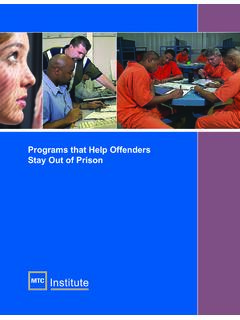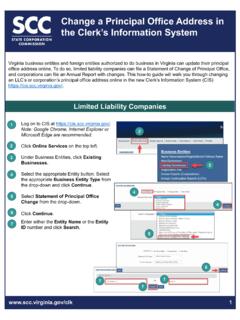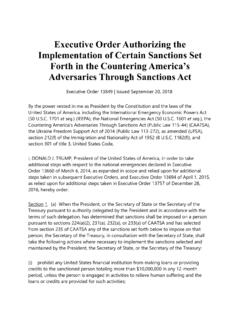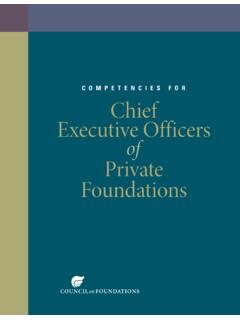Transcription of Correctional Officers: Strategies to Improve Retention - MTC
1 Correctional Officers: Strategies to Improve RetentionCorrectional Officers: Strategies to Improve RetentionACKNOWLEDGEMENTSThe Institute is grateful to those reviewers who shared comments on this document. Their participation has enhanced the value of the information for policy makers and colleagues working in corrections. We also recognize the valuable guidance and feedback on this project from Odie Washington, Sr. Vice President, Corrections, Roberts T. Jones, MTC Institute President and commentary from Scott Marquardt, MTC President & CEO, whose input helped make this document stronger. From the field, we extend thanks to the various MTC executive staff who contributed their insight and experience to the also wish to thank Cindy Goulding, an independent consultant who provided much of the research literature and early drafts of the document as well as Meghan Knowles and John Newhall, who as interns, helped in reviewing the literature and contributing to the drafting of this document.
2 In addition, the Institute appreciates the contributions from Larry Bell, National Account Manager Corrections, USIS, to the applicant screening portion of this report. Correctional Officers: Strategies to Improve Retention (2nd Edition)Published by MTC Institute. Copyright January Author: Carl Nink Comments are appreciated and should be directed to Carl Nink, Executive Director at:MTC Institute500 North Marketplace Drive Box 10 Centerville, UT 84014(801) 693-2870 Fax: (801) & Training Corporation (MTC) is an international corporation dedicated to helping people realize their learning potential. MTC creates nurturing environments in which education is encouraged and rehabilitation is recognized. MTC operates 16 contracted Correctional facilities across the country with approximately 19,000 beds under contract. MTC also manages and operates 26 Job Corps centers in 19 states for the Department of Labor, preparing disadvantaged youth for meaningful careers.
3 In addition, MTC has expanded its education and vocational expertise into the international arena, working in countries such as Iraq, Sudan, Tunisia, China and Mongolia. The MTC Institute is the research division of MTC, which is dedicated to promoting innovations and exemplary practices and projecting trends that are relevant to job training and corrections. The work of the Institute is geared toward a broad audience including policy makers, educators, researchers, practitioners, state and federal officials, workforce development entities, Correctional agencies, and Job Corps of ContentsINTRODUCTION ..1 BUDGET CHALLENGES ..2 POPULATION AND WORKFORCE PROJECTIONS ..2 Correctional ENVIRONMENT ..2 Prison Populations ..3 Bureau of Labor Statistics Projections: Protective Services ..3 Women in the Workforce ..3 Multi-generational Workforce ..4 PREDICTORS OF TURNOVER.
4 4 WHY Correctional OFFICERS LEAVE ..5 Addressing the #1 Employee Reason for Leaving: Lack of Career Development ..6 Retention STRATEGY FOCUS AREAS ..6 Job Satisfaction ..7 Organizational Commitment ..8 Applicant Screening ..8 New Employee Orientation ..9 Supervisory Relations ..9 Work Environment ..10 Training and Development ..11 Salary and Benefits ..12 CONCLUSION ..13 APPENDIx A ..15 ENDNOTES ..16 RESOURCES ..20 Correctional Officers: Strategies to Improve Retention1 MANAGEMENT & TRAINING CORPORATIONINTRODUCTIONMany corrections professionals refer to Correctional officers (COs) as the backbone of the prison system. If this common perception is accepted, COs must be considered the system s most valuable employees. Unfortunately, the turnover of Correctional officers nationwide is very high. Moreover, rapid turnover is making it nearly impossible for prison systems and Correctional administrators to cost-effectively provide an experienced security workforce.
5 Review of material related to CO turnover uncovered several important issues. Perhaps most significant: CO turnover remains high, and the cost of replacing these critical employees is growing. In addition, prison populations are increasing, contributing to the problems associated with Retention of prison staff. Despite current unemployment statistics, the labor market is getting tighter ( , more jobs are available for a shrinking skilled workforce). Furthermore, state and federal budgets are being squeezed tightly, and cannot be counted upon to resolve these issues any time significant CO pay increases are highly unlikely and recruitment incentives are not working as well as intended, managers need to implement proven employee Retention Strategies . Fortunately, some fundamental human resource practices that can help Improve Retention are available at little or no cost to Correctional agencies and managers.
6 This report explores issues impacting Correctional agencies and companies, such as changing workforce demands, a dynamic labor market, predictors of turnover, and various reasons for why COs leave their positions. Research presented in this study suggests Strategies in a number of focus areas ( , applicant screening, new employee orientation, job satisfaction, organizational commitment, supervisory relations, work environment, training and development, and salary and benefits) to Improve Retention of Correctional officers. The average turnover rates for state Correctional security staff from 2000 to 2008, while higher and costlier than agencies would want, were somewhat stable over the years, with a range from percent in Nebraska to as low as 0 percent reported by New Jersey; the average sitting at percent on September 30, 2008, as noted in Figure a dynamic and competitive global marketplace, corrections is a multibillion-dollar industry that brings a heavy tax burden.
7 Its institutions are predominantly managed by public agencies, with only percent of the industry managed by private companies at the end of year Corrections professionals are aware that inmate populations are not only increasing, but are becoming more multicultural and multi-generational, which adds to the difficulty of the CO s role. This adds another dimension to the problem of turnover, but we have an even bigger issue looming; a bulge of staff retiring with fewer skilled workers entering the workforce. This situation necessitates a focused strategic plan to deal with the emerging demand for replacements. Therefore, it is very important for managers to understand the issues surrounding turnover and implement informed Strategies which address how to effectively recruit and retain Correctional staff. With the high cost associated with each newly hired Correctional officer and shrinking budgets, the Retention of COs is a critical issue for all elected officials, public policy makers, and Correctional administrators.
8 America faces a future in which we have too few workers and especially, too few skilled workers. 3 Figure 12 Correctional Officers: Strategies to Improve RetentionBUDGET CHALLENGESA fter cutting nearly $73 billion to make up for gaps in funding Fiscal Year (FY) 2009 budgets and over $113 billion in FY 2010 budgets, states are being forced to cut even more to make future budgets As a consequence of lower revenue from state sales and income tax, many experts are predicting that there will be budget shortfalls of $ billion in FY 2011 and $ billion for FY With about a third of annual state revenues coming from personal income taxes, states are expecting a more difficult time in the future as they observe a massive drop in revenue from a sustained loss of jobs and a corresponding decrease in personal income taxes paid, as well as Medicaid spending up almost eight percent in FY Overall, revenues were down in the first two quarters of FY 2009 almost 12 percent and 17 percent According to the report by the National Governors Association.
9 State revenues will likely not recover until 2014 or 2015 with some predictions that shortfalls could reach $350 corrections budgets being the fifth largest state budget category, competition with other spending priorities, such as education, infrastructure, and health, is very In response, elected officials are calling for improved performance from corrections systems and specifically, reductions in Across 34 states, nearly 9 of 10 Correctional dollars went to prisons in FY 2008, with the balance funding other Correctional interests ( parole, probation, electronic monitoring, etc).11 During fiscal year 2009, Correctional budgets were cut almost $700 million, much of it by eliminating staff and programming for inmates. 12 This approach has a long-term cost associated with the decision in terms of inmates, without rehabilitation, returning to Correctional budgets will likely continue to have minimal potential for growth in the area of staff funding.
10 Diminished funding influences the Correctional work environment beyond program reductions. An agency s organizational culture and its ability to market itself are often affected. POPULATION AND WORKFORCE PROJECTIONSA gencies are extremely challenged to meet the rising demand for staff with a diminishing workforce. America faces a future in which we have too few workers and especially, too few skilled workers. 13 According to the Bureau of Labor Statistics, total employment is expected to increase by million, from million in 2008 to million in 2018. 14 Yet the percent annual growth rate in the workforce needed to fill the jobs is lower than the percent annual growth rate registered during the previous 10-year period; the civilian labor force is projected to increase only by about 13 million, reaching million in This means employers must satisfy increasing position requirements with a shrinking talent pool.










